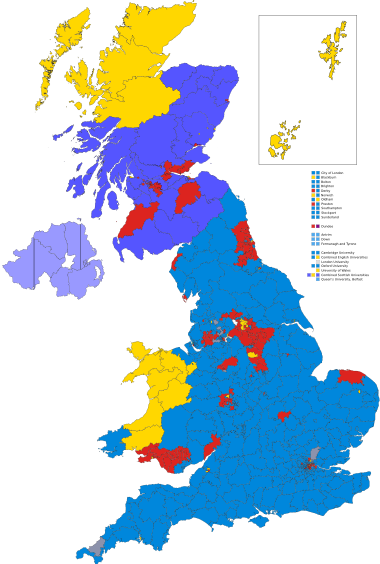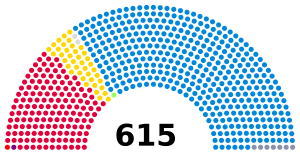1924 United Kingdom general election facts for kids
|
|||||||||||||||||||||||||||||||||||||||||||||
|
|
|||||||||||||||||||||||||||||||||||||||||||||
|
All 615 seats in the House of Commons 308 seats needed for a majority |
|||||||||||||||||||||||||||||||||||||||||||||
|---|---|---|---|---|---|---|---|---|---|---|---|---|---|---|---|---|---|---|---|---|---|---|---|---|---|---|---|---|---|---|---|---|---|---|---|---|---|---|---|---|---|---|---|---|---|
| Turnout | 77.0%, |
||||||||||||||||||||||||||||||||||||||||||||
|
|||||||||||||||||||||||||||||||||||||||||||||

Colours denote the winning party—as shown in as shown in 1924 United Kingdom general election § Notes
|
|||||||||||||||||||||||||||||||||||||||||||||
|
|||||||||||||||||||||||||||||||||||||||||||||
The 1924 United Kingdom general election was a big vote held on Wednesday, October 29, 1924. It happened because the Labour government, led by Prime Minister Ramsay MacDonald, lost a vote in the House of Commons. This meant they no longer had enough support to lead the country. It was the third general election in less than two years, which was quite unusual!
The Conservatives, led by Stanley Baldwin, won a lot more seats than before. They gained a large majority of 209 seats in Parliament. The Labour Party, led by MacDonald, lost 40 of their seats. The election was also very tough for the Liberal Party, led by H. H. Asquith. They lost 118 out of their 158 seats. This election made British politics mostly about two main parties: Labour and the Conservatives.
One big reason for the Conservative victory and Labour's loss was something called the Zinoviev letter. This was a fake document that was published as if it were real in a newspaper called the Daily Mail just four days before the election. It caused a lot of excitement and worry. Even though Labour's total votes went up by about a million, this was mainly because they had more candidates running in this election compared to the one in 1923.
Before this election, in 1923, the Conservatives had called an early election to get support for a new trade policy. This policy was called "protectionism" or "imperial preference," which meant putting taxes on goods from other countries to help British businesses. But they lost their majority then. In 1924, they changed their minds and supported "free trade" (no taxes on imports), and they won back power.
Contents
Why the Election Happened
After the 1923 election, the Labour Party was the second-largest party. But they formed their first-ever government with help from the Liberal Party. This happened because the ruling Conservative Party had lost its majority, so their leader, Stanley Baldwin, couldn't stay as Prime Minister.
However, Labour and the Liberals didn't get along very well. Eventually, a Liberal Member of Parliament (MP) named Sir John Simon called for a "motion of no confidence" in MacDonald's government. This motion passed, meaning most MPs didn't trust the government anymore.
Asquith, the Liberal leader, thought that neither the Conservatives nor Labour would want another election so soon. He hoped one of them would have to team up with the Liberals. But his plan didn't work. MacDonald decided to call an election instead. He knew the Conservatives would likely win big, but he gambled that it would hurt the Liberals the most. MacDonald was right. The Liberals, who relied a lot on money from David Lloyd George, struggled financially during the campaign. Meanwhile, Labour got more support from workers' unions and could run a bigger campaign.
Key Reasons for the Results
Many people believe that Labour forming its first government in early 1924, combined with the Zinoviev letter, made many traditional Liberal voters worried about "socialism." This fear caused them to switch their support to the Conservative Party. This helps explain why the Liberal Party did so poorly.
The Liberal Party also faced other problems:
- They had money troubles, so they could only run candidates in 339 areas.
- They didn't have many unique policies after the Conservatives stopped supporting "protected trade."
- Their leader, Asquith, was not doing well. He even lost his own seat in Parliament for the second time in six years. This was Asquith's last election. He later became a Lord and led the party from the House of Lords.
There was also a smaller group called the Constitutionalists, led by Winston Churchill. They wanted the Conservatives and Liberals to work together. Seven of them were elected, and three, including Churchill, later joined the Conservatives.
The Sinn Féin party also ran candidates for the first time in a while, but none of them won.
This election was also the first in the UK to have party political broadcasts. Parties used BBC Radio to share their messages with voters.
Election Results Summary
| Candidates | Votes | ||||||||||
|---|---|---|---|---|---|---|---|---|---|---|---|
| Party | Leader | Stood | Elected | Gained | Unseated | Net | % of total | % | No. | Net % | |
| Conservative | Stanley Baldwin | 534 | 412 | 164 | 10 | +154 | 66.99 | 46.8 | 7,418,983 | +8.8 | |
| Labour | Ramsay MacDonald | 514 | 151 | 23 | 63 | −40 | 24.55 | 33.3 | 5,281,626 | +2.6 | |
| Liberal | H. H. Asquith | 339 | 40 | 10 | 128 | −118 | 6.5 | 17.8 | 2,818,717 | −11.9 | |
| Constitutionalist | N/A | 12 | 7 | 7 | 0 | +7 | 1.14 | 1.2 | 185,075 | +1.1 | |
| Communist | Albert Inkpin | 8 | 1 | 1 | 0 | +1 | 0.16 | 0.2 | 51,176 | +0.1 | |
| Sinn Féin | Éamon de Valera | 8 | 0 | 0 | 0 | 0 | 0.2 | 34,181 | N/A | ||
| Independent | N/A | 7 | 2 | 1 | 1 | 0 | 0.2 | 25,206 | −0.1 | ||
| NI Labour | Sam Kyle | 1 | 0 | 0 | 0 | 0 | 0.1 | 21,122 | N/A | ||
| Scottish Prohibition | Edwin Scrymgeour | 1 | 1 | 0 | 0 | 0 | 0.1 | 14,596 | 0.0 | ||
| Independent Liberal | N/A | 1 | 0 | 0 | 1 | −1 | 0.0 | 3,241 | −0.1 | ||
| Independent Labour | N/A | 1 | 0 | 0 | 0 | 0 | 0.0 | 1,775 | −0.1 | ||
| Ind U | N/A | 1 | 0 | 0 | 0 | 0 | 0.0 | 517 | −0.1 | ||
| Irish Nationalist | T. P. O'Connor | 1 | 1 | 0 | 0 | 0 | 0.0 | 0 | −0.4 | ||
How People Voted
| Popular vote | ||||
|---|---|---|---|---|
| Conservative | 46.79% | |||
| Labour | 30.68% | |||
| Liberal | 17.78% | |||
| Others | 4.75% | |||
How Many Seats Each Party Won
| Parliamentary seats | ||||
|---|---|---|---|---|
| Conservative | 66.99% | |||
| Labour | 24.55% | |||
| Liberal | 6.50% | |||
| Others | 1.96% | |||
See also
- List of MPs elected in the 1924 United Kingdom general election
- 1924 United Kingdom general election in Northern Ireland





